HI6006 Competitive Strategy: IKEA's Business in the Indian Market
VerifiedAdded on 2022/11/13
|13
|2737
|437
Case Study
AI Summary
This case study provides a detailed analysis of IKEA's business model and competitive strategy in the Indian market. It identifies key strategic issues IKEA faced, including navigating government regulations, securing retail space, and adapting to local consumer preferences. The analysis explores how IKEA addressed challenges like mandatory sourcing requirements and logistical hurdles by negotiating with the government, adopting suburban store locations, and modifying its product offerings. The report also examines IKEA's efforts to compete with local carpenters and established retailers by establishing a manufacturing unit and offering customized services, highlighting the company's strategies for gaining customer trust and market share in India. Desklib is a great platform for students to find similar solved assignments.
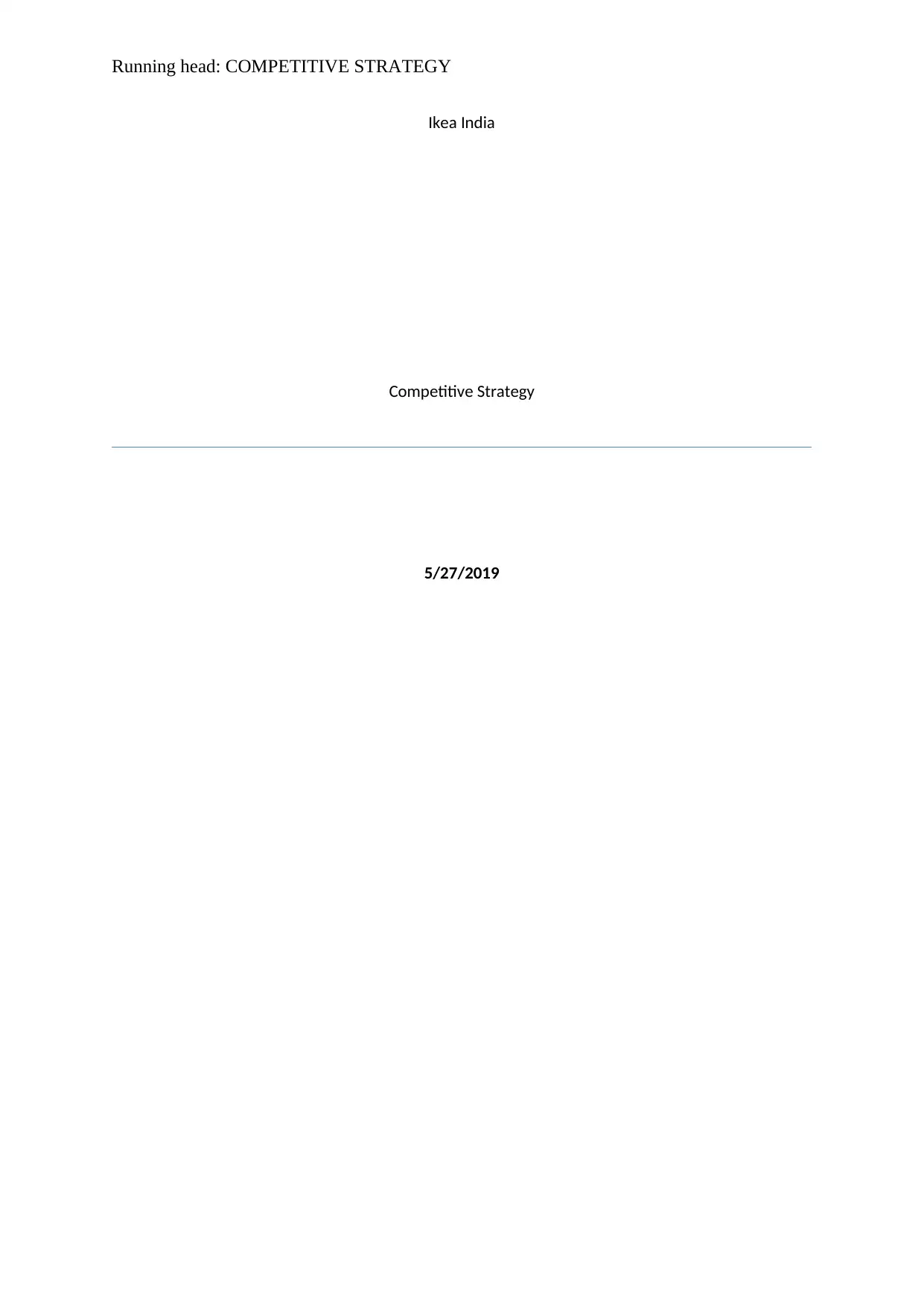
Running head: COMPETITIVE STRATEGY
Ikea India
Competitive Strategy
5/27/2019
Ikea India
Competitive Strategy
5/27/2019
Paraphrase This Document
Need a fresh take? Get an instant paraphrase of this document with our AI Paraphraser
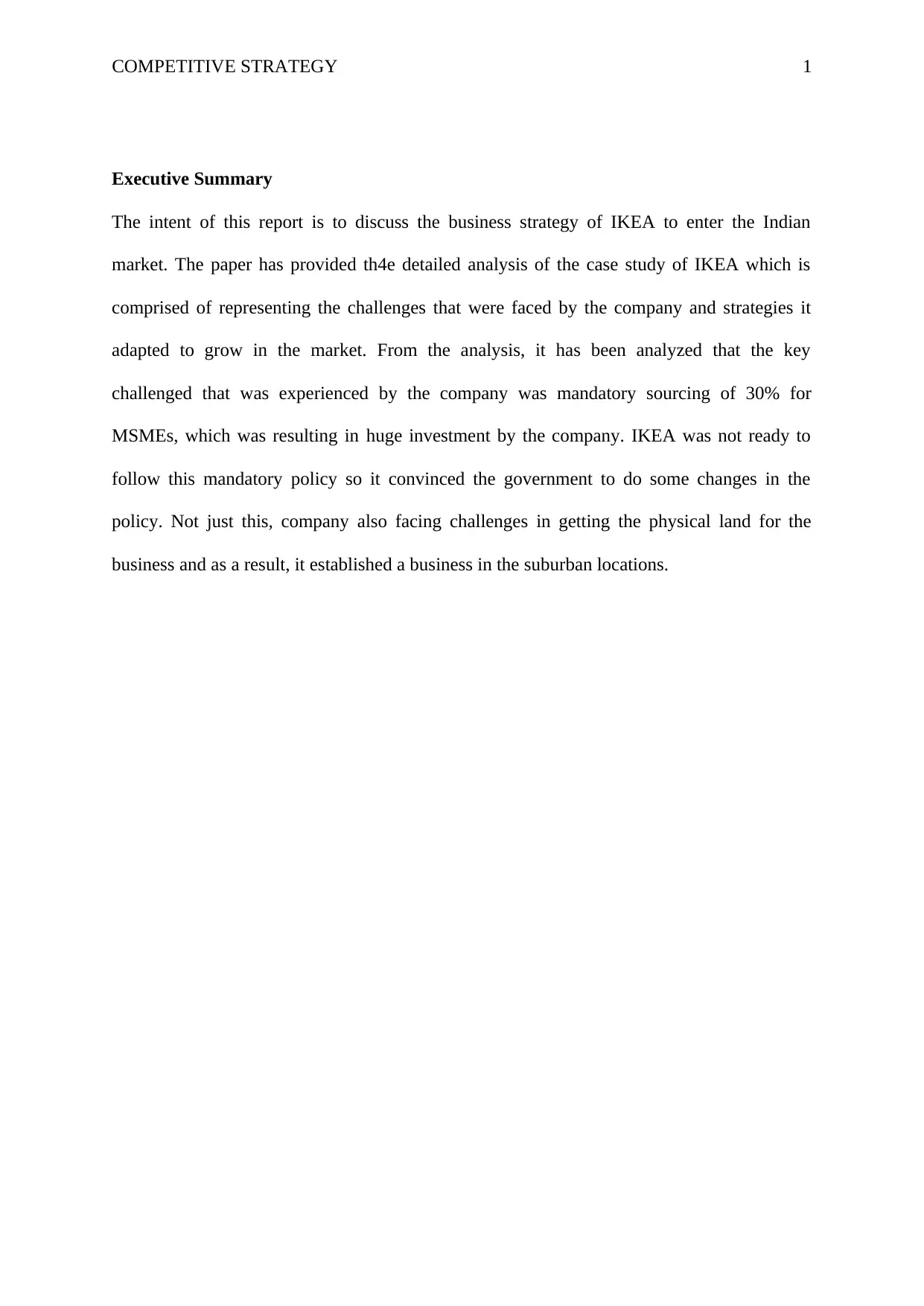
COMPETITIVE STRATEGY 1
Executive Summary
The intent of this report is to discuss the business strategy of IKEA to enter the Indian
market. The paper has provided th4e detailed analysis of the case study of IKEA which is
comprised of representing the challenges that were faced by the company and strategies it
adapted to grow in the market. From the analysis, it has been analyzed that the key
challenged that was experienced by the company was mandatory sourcing of 30% for
MSMEs, which was resulting in huge investment by the company. IKEA was not ready to
follow this mandatory policy so it convinced the government to do some changes in the
policy. Not just this, company also facing challenges in getting the physical land for the
business and as a result, it established a business in the suburban locations.
Executive Summary
The intent of this report is to discuss the business strategy of IKEA to enter the Indian
market. The paper has provided th4e detailed analysis of the case study of IKEA which is
comprised of representing the challenges that were faced by the company and strategies it
adapted to grow in the market. From the analysis, it has been analyzed that the key
challenged that was experienced by the company was mandatory sourcing of 30% for
MSMEs, which was resulting in huge investment by the company. IKEA was not ready to
follow this mandatory policy so it convinced the government to do some changes in the
policy. Not just this, company also facing challenges in getting the physical land for the
business and as a result, it established a business in the suburban locations.
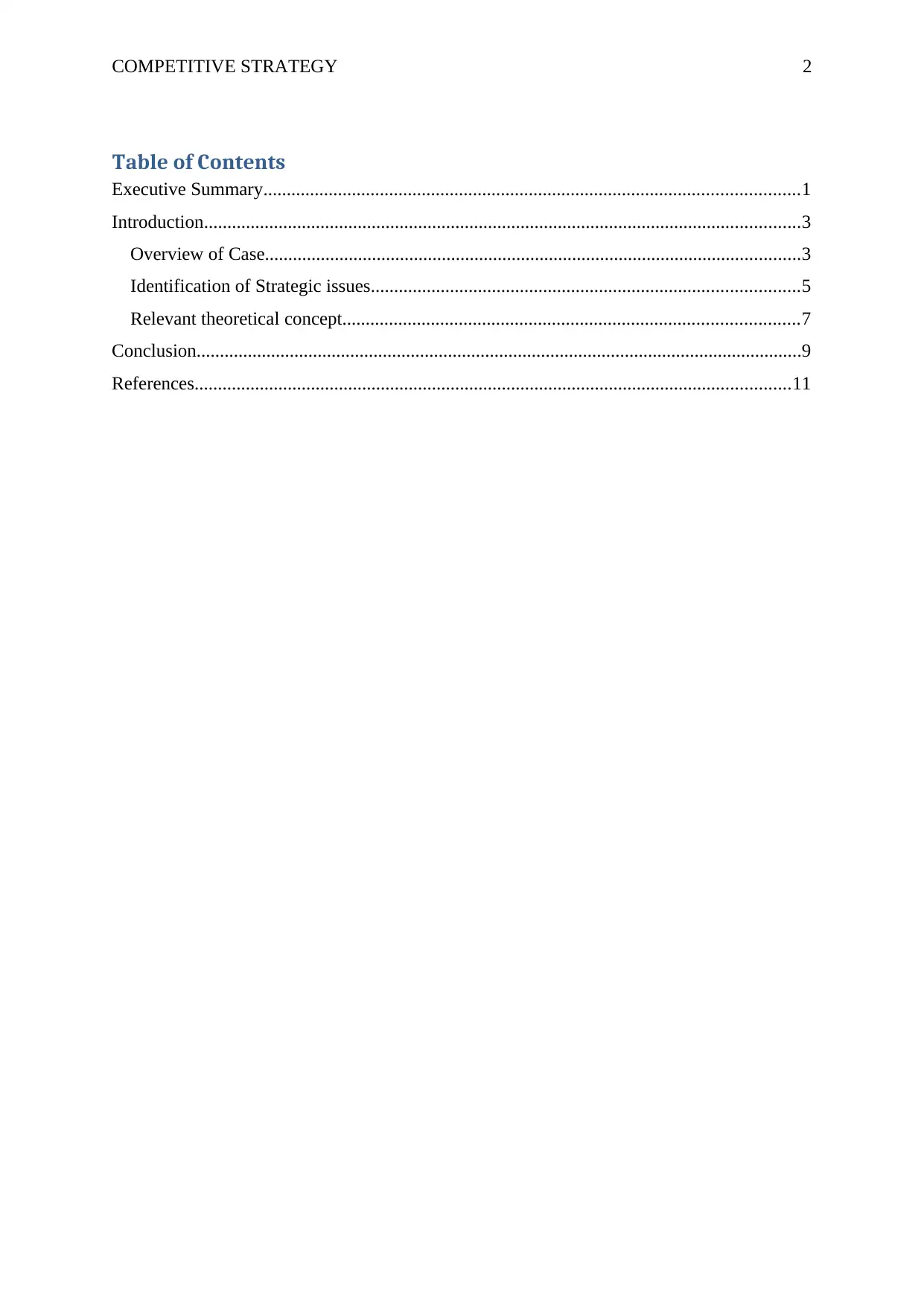
COMPETITIVE STRATEGY 2
Table of Contents
Executive Summary...................................................................................................................1
Introduction................................................................................................................................3
Overview of Case...................................................................................................................3
Identification of Strategic issues............................................................................................5
Relevant theoretical concept..................................................................................................7
Conclusion..................................................................................................................................9
References................................................................................................................................11
Table of Contents
Executive Summary...................................................................................................................1
Introduction................................................................................................................................3
Overview of Case...................................................................................................................3
Identification of Strategic issues............................................................................................5
Relevant theoretical concept..................................................................................................7
Conclusion..................................................................................................................................9
References................................................................................................................................11
⊘ This is a preview!⊘
Do you want full access?
Subscribe today to unlock all pages.

Trusted by 1+ million students worldwide
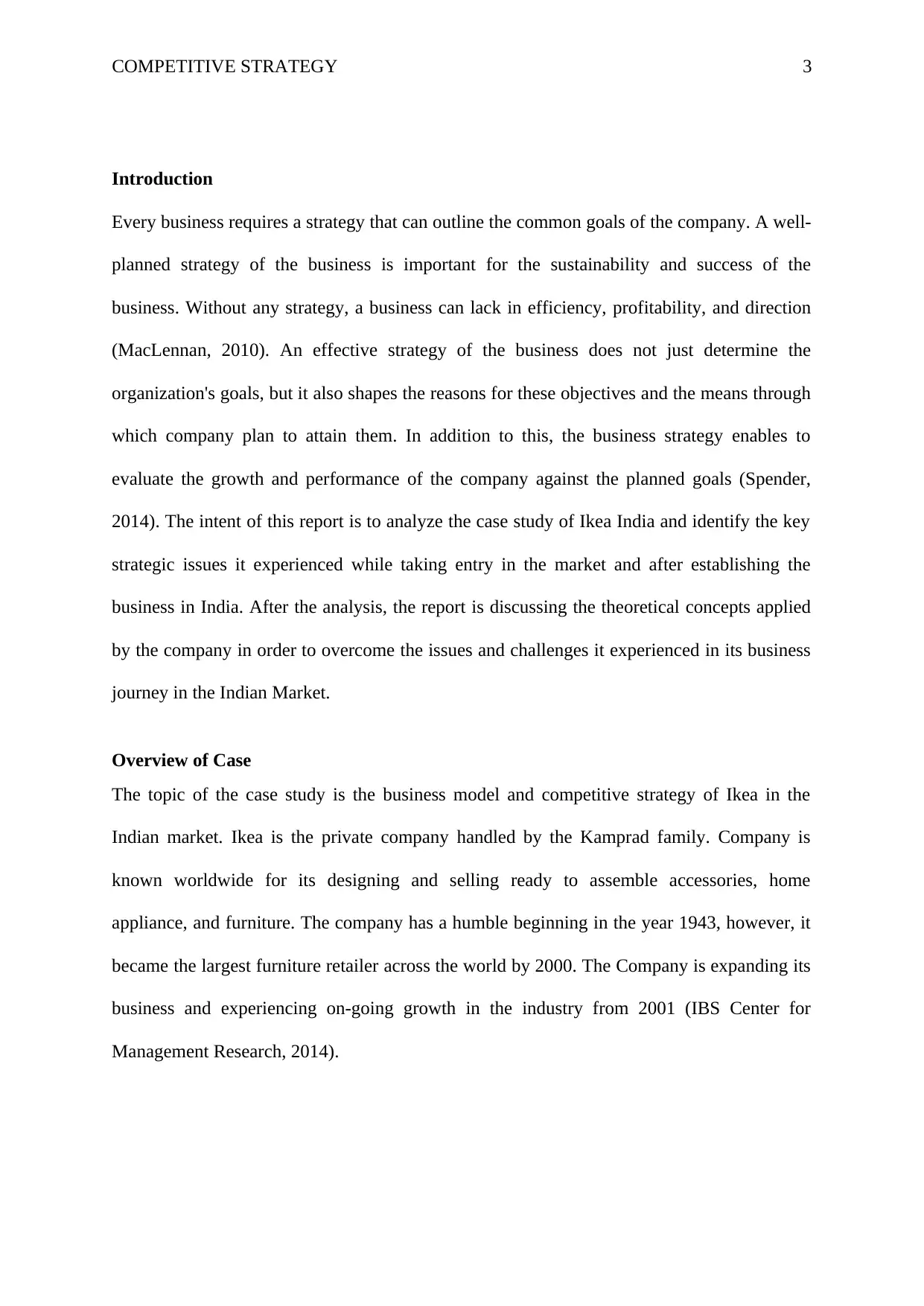
COMPETITIVE STRATEGY 3
Introduction
Every business requires a strategy that can outline the common goals of the company. A well-
planned strategy of the business is important for the sustainability and success of the
business. Without any strategy, a business can lack in efficiency, profitability, and direction
(MacLennan, 2010). An effective strategy of the business does not just determine the
organization's goals, but it also shapes the reasons for these objectives and the means through
which company plan to attain them. In addition to this, the business strategy enables to
evaluate the growth and performance of the company against the planned goals (Spender,
2014). The intent of this report is to analyze the case study of Ikea India and identify the key
strategic issues it experienced while taking entry in the market and after establishing the
business in India. After the analysis, the report is discussing the theoretical concepts applied
by the company in order to overcome the issues and challenges it experienced in its business
journey in the Indian Market.
Overview of Case
The topic of the case study is the business model and competitive strategy of Ikea in the
Indian market. Ikea is the private company handled by the Kamprad family. Company is
known worldwide for its designing and selling ready to assemble accessories, home
appliance, and furniture. The company has a humble beginning in the year 1943, however, it
became the largest furniture retailer across the world by 2000. The Company is expanding its
business and experiencing on-going growth in the industry from 2001 (IBS Center for
Management Research, 2014).
Introduction
Every business requires a strategy that can outline the common goals of the company. A well-
planned strategy of the business is important for the sustainability and success of the
business. Without any strategy, a business can lack in efficiency, profitability, and direction
(MacLennan, 2010). An effective strategy of the business does not just determine the
organization's goals, but it also shapes the reasons for these objectives and the means through
which company plan to attain them. In addition to this, the business strategy enables to
evaluate the growth and performance of the company against the planned goals (Spender,
2014). The intent of this report is to analyze the case study of Ikea India and identify the key
strategic issues it experienced while taking entry in the market and after establishing the
business in India. After the analysis, the report is discussing the theoretical concepts applied
by the company in order to overcome the issues and challenges it experienced in its business
journey in the Indian Market.
Overview of Case
The topic of the case study is the business model and competitive strategy of Ikea in the
Indian market. Ikea is the private company handled by the Kamprad family. Company is
known worldwide for its designing and selling ready to assemble accessories, home
appliance, and furniture. The company has a humble beginning in the year 1943, however, it
became the largest furniture retailer across the world by 2000. The Company is expanding its
business and experiencing on-going growth in the industry from 2001 (IBS Center for
Management Research, 2014).
Paraphrase This Document
Need a fresh take? Get an instant paraphrase of this document with our AI Paraphraser
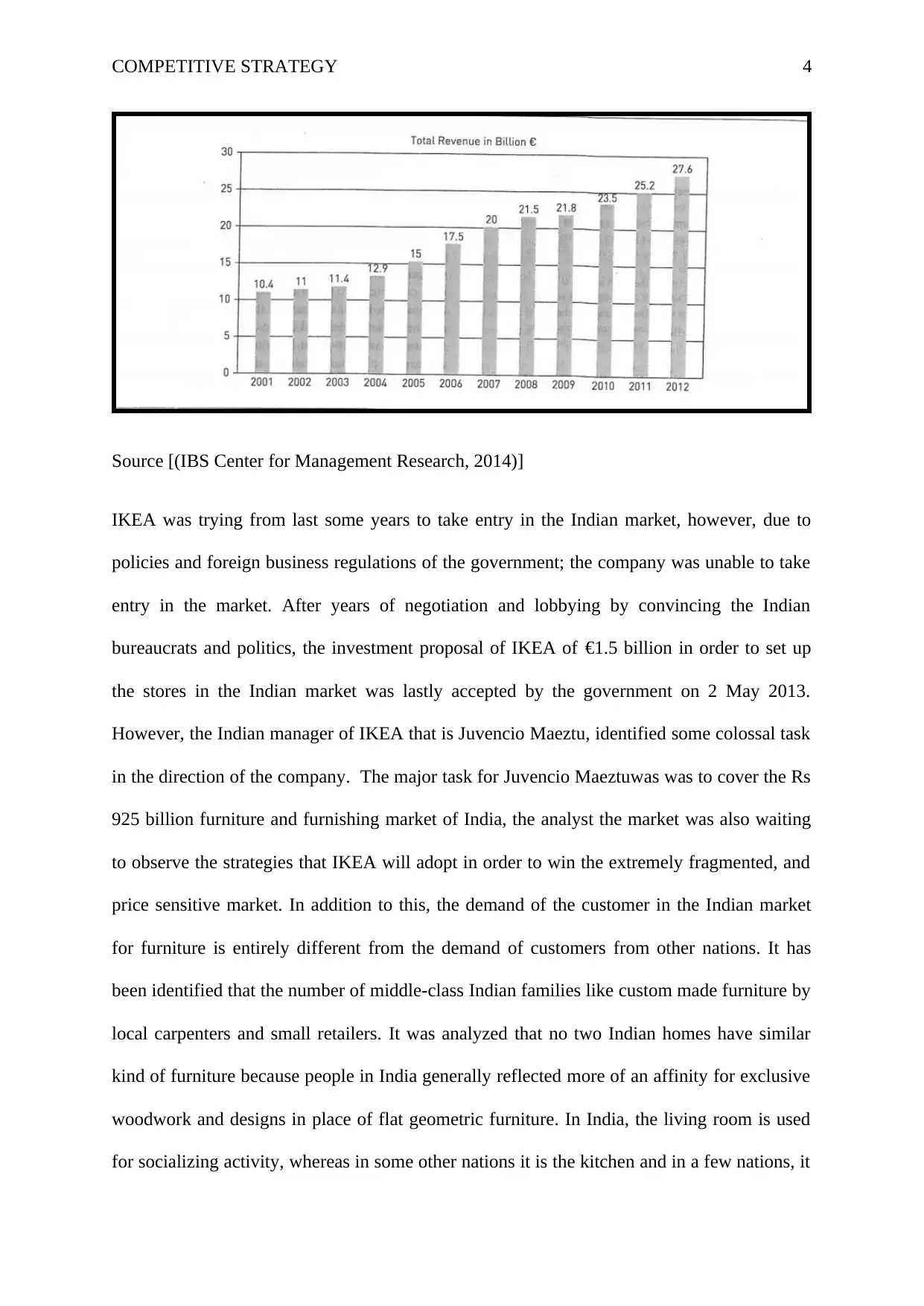
COMPETITIVE STRATEGY 4
Source [(IBS Center for Management Research, 2014)]
IKEA was trying from last some years to take entry in the Indian market, however, due to
policies and foreign business regulations of the government; the company was unable to take
entry in the market. After years of negotiation and lobbying by convincing the Indian
bureaucrats and politics, the investment proposal of IKEA of €1.5 billion in order to set up
the stores in the Indian market was lastly accepted by the government on 2 May 2013.
However, the Indian manager of IKEA that is Juvencio Maeztu, identified some colossal task
in the direction of the company. The major task for Juvencio Maeztuwas was to cover the Rs
925 billion furniture and furnishing market of India, the analyst the market was also waiting
to observe the strategies that IKEA will adopt in order to win the extremely fragmented, and
price sensitive market. In addition to this, the demand of the customer in the Indian market
for furniture is entirely different from the demand of customers from other nations. It has
been identified that the number of middle-class Indian families like custom made furniture by
local carpenters and small retailers. It was analyzed that no two Indian homes have similar
kind of furniture because people in India generally reflected more of an affinity for exclusive
woodwork and designs in place of flat geometric furniture. In India, the living room is used
for socializing activity, whereas in some other nations it is the kitchen and in a few nations, it
Source [(IBS Center for Management Research, 2014)]
IKEA was trying from last some years to take entry in the Indian market, however, due to
policies and foreign business regulations of the government; the company was unable to take
entry in the market. After years of negotiation and lobbying by convincing the Indian
bureaucrats and politics, the investment proposal of IKEA of €1.5 billion in order to set up
the stores in the Indian market was lastly accepted by the government on 2 May 2013.
However, the Indian manager of IKEA that is Juvencio Maeztu, identified some colossal task
in the direction of the company. The major task for Juvencio Maeztuwas was to cover the Rs
925 billion furniture and furnishing market of India, the analyst the market was also waiting
to observe the strategies that IKEA will adopt in order to win the extremely fragmented, and
price sensitive market. In addition to this, the demand of the customer in the Indian market
for furniture is entirely different from the demand of customers from other nations. It has
been identified that the number of middle-class Indian families like custom made furniture by
local carpenters and small retailers. It was analyzed that no two Indian homes have similar
kind of furniture because people in India generally reflected more of an affinity for exclusive
woodwork and designs in place of flat geometric furniture. In India, the living room is used
for socializing activity, whereas in some other nations it is the kitchen and in a few nations, it

COMPETITIVE STRATEGY 5
is used for sleeping. Hence, all these changes in the preference of the customer were a huge
task for the company (IBS Center for Management Research, 2014).
Identification of Strategic issues
1. The major issue that IKEA experienced is permission from the local government of India
to establish a business in the market. Some of the regulations and policies of the government
such as mandatory source of 30% of the company's raw material and goods from the micro,
small, and medium enterprises of India (Bailay, 2015). This raised a huge challenge in front
of the entry of IKEA in the Indian market.
2. Another major challenge experienced by IKEA in introducing its stores in the Indian
market was the accessibility of the retail space and its cost. The stores of IKEA in India were
unlikely to be of 350000 square feet and even smaller than this size. Few of the largest size
stores of the company across the world had an area of around 606000 square feet. Such huge
spacing area in the India mall was impossible. The initiative taken by IKEA in the year 2006
of the usage of 100% renewable energy mandates its stores to be provided with the energy
from solar panels or wind power (Chua, 2015). The stores of the company in Sweden, France,
and Germany and at other 40 places make use of wind turbines or solar panels. Establishing
this kind of accommodation in the Indian market with such severe energy requirements was
uncertain.
3. In India, the real estate cost is high, availability of the retail space is one of the key issues
and overall efficiency of the store is a huge challenge (ILO Consulting, 2019).
4. Considering the Indian market scenario, the company cannot apply the same global model
in the Indian market. There were required to develop an India-specific strategy. Besides this,
due to its selected suburban location for the infrastructure set up, the company experienced
challenges in the Indian market. As the business is located in the suburban area away from
is used for sleeping. Hence, all these changes in the preference of the customer were a huge
task for the company (IBS Center for Management Research, 2014).
Identification of Strategic issues
1. The major issue that IKEA experienced is permission from the local government of India
to establish a business in the market. Some of the regulations and policies of the government
such as mandatory source of 30% of the company's raw material and goods from the micro,
small, and medium enterprises of India (Bailay, 2015). This raised a huge challenge in front
of the entry of IKEA in the Indian market.
2. Another major challenge experienced by IKEA in introducing its stores in the Indian
market was the accessibility of the retail space and its cost. The stores of IKEA in India were
unlikely to be of 350000 square feet and even smaller than this size. Few of the largest size
stores of the company across the world had an area of around 606000 square feet. Such huge
spacing area in the India mall was impossible. The initiative taken by IKEA in the year 2006
of the usage of 100% renewable energy mandates its stores to be provided with the energy
from solar panels or wind power (Chua, 2015). The stores of the company in Sweden, France,
and Germany and at other 40 places make use of wind turbines or solar panels. Establishing
this kind of accommodation in the Indian market with such severe energy requirements was
uncertain.
3. In India, the real estate cost is high, availability of the retail space is one of the key issues
and overall efficiency of the store is a huge challenge (ILO Consulting, 2019).
4. Considering the Indian market scenario, the company cannot apply the same global model
in the Indian market. There were required to develop an India-specific strategy. Besides this,
due to its selected suburban location for the infrastructure set up, the company experienced
challenges in the Indian market. As the business is located in the suburban area away from
⊘ This is a preview!⊘
Do you want full access?
Subscribe today to unlock all pages.

Trusted by 1+ million students worldwide
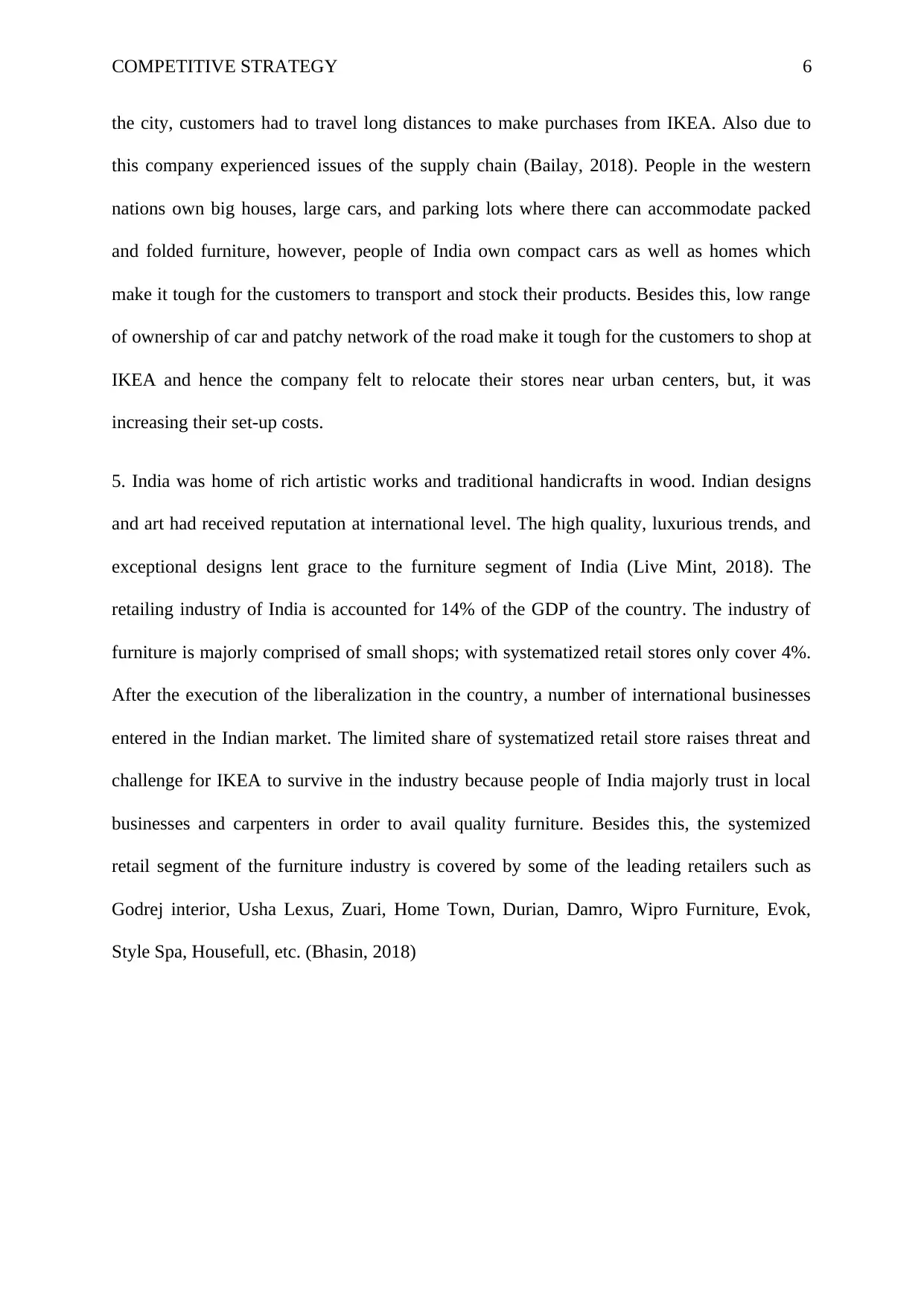
COMPETITIVE STRATEGY 6
the city, customers had to travel long distances to make purchases from IKEA. Also due to
this company experienced issues of the supply chain (Bailay, 2018). People in the western
nations own big houses, large cars, and parking lots where there can accommodate packed
and folded furniture, however, people of India own compact cars as well as homes which
make it tough for the customers to transport and stock their products. Besides this, low range
of ownership of car and patchy network of the road make it tough for the customers to shop at
IKEA and hence the company felt to relocate their stores near urban centers, but, it was
increasing their set-up costs.
5. India was home of rich artistic works and traditional handicrafts in wood. Indian designs
and art had received reputation at international level. The high quality, luxurious trends, and
exceptional designs lent grace to the furniture segment of India (Live Mint, 2018). The
retailing industry of India is accounted for 14% of the GDP of the country. The industry of
furniture is majorly comprised of small shops; with systematized retail stores only cover 4%.
After the execution of the liberalization in the country, a number of international businesses
entered in the Indian market. The limited share of systematized retail store raises threat and
challenge for IKEA to survive in the industry because people of India majorly trust in local
businesses and carpenters in order to avail quality furniture. Besides this, the systemized
retail segment of the furniture industry is covered by some of the leading retailers such as
Godrej interior, Usha Lexus, Zuari, Home Town, Durian, Damro, Wipro Furniture, Evok,
Style Spa, Housefull, etc. (Bhasin, 2018)
the city, customers had to travel long distances to make purchases from IKEA. Also due to
this company experienced issues of the supply chain (Bailay, 2018). People in the western
nations own big houses, large cars, and parking lots where there can accommodate packed
and folded furniture, however, people of India own compact cars as well as homes which
make it tough for the customers to transport and stock their products. Besides this, low range
of ownership of car and patchy network of the road make it tough for the customers to shop at
IKEA and hence the company felt to relocate their stores near urban centers, but, it was
increasing their set-up costs.
5. India was home of rich artistic works and traditional handicrafts in wood. Indian designs
and art had received reputation at international level. The high quality, luxurious trends, and
exceptional designs lent grace to the furniture segment of India (Live Mint, 2018). The
retailing industry of India is accounted for 14% of the GDP of the country. The industry of
furniture is majorly comprised of small shops; with systematized retail stores only cover 4%.
After the execution of the liberalization in the country, a number of international businesses
entered in the Indian market. The limited share of systematized retail store raises threat and
challenge for IKEA to survive in the industry because people of India majorly trust in local
businesses and carpenters in order to avail quality furniture. Besides this, the systemized
retail segment of the furniture industry is covered by some of the leading retailers such as
Godrej interior, Usha Lexus, Zuari, Home Town, Durian, Damro, Wipro Furniture, Evok,
Style Spa, Housefull, etc. (Bhasin, 2018)
Paraphrase This Document
Need a fresh take? Get an instant paraphrase of this document with our AI Paraphraser

COMPETITIVE STRATEGY 7
Source [(IBS Center for Management Research, 2014)]
Relevant theoretical concept
1. IKEA was regularly trying to convince the government of India to change the sourcing
rules. In 2012, IKEA expressed issues that it will experience due to sourcing rules that it if
the company purchased products from the micro, small, and medium enterprise, they will
soon be the large set-ups. They IKEA again have to search for other MSMEs, which will
Source [(IBS Center for Management Research, 2014)]
Relevant theoretical concept
1. IKEA was regularly trying to convince the government of India to change the sourcing
rules. In 2012, IKEA expressed issues that it will experience due to sourcing rules that it if
the company purchased products from the micro, small, and medium enterprise, they will
soon be the large set-ups. They IKEA again have to search for other MSMEs, which will

COMPETITIVE STRATEGY 8
influence its supply chain network and quality of the products. There were rumors in the
media that the clause of sourcing will be relaxed. In the month of September of the same
year, the government of India twisted its clause of sourcing. It altered ‘mandatory sourcing
from MSME to ‘preferable from MSMEs' and supposed that international organizations are
getting relaxation in the norms of 30% procurement but have to establish their manufacturing
unit in the Indian market. IKEA accepted this norm of the Indian government and submitted
its final paperwork on 8 October 2012 (Business Standard, 2019). In order to assure the
government, in its application IKEA confirmed that the old furniture that will be purchased
from the customer of India in exchange of new ones will not be again sold in the market and
in place of this, they will be donated to the third party small business or needy families by the
help of charitable organizations.
2. Considering the issue related to the required size of the store that experienced by the
company, IKEA planned to operate nine stores in seven years, two stores each in Bangalore
and Mumbai and one each store in Pune, Hyderabad, and Chennai. Hence, with the present
space restrictions in the Indian market, IKEA has adopted standalone suburban stores. In the
Indian market, the real estate costs are very high, availability of the retail space is the big
issue (Bagaria, 2012).
3. In order to overcome the challenge of availability of huge land for establishing the
infrastructure, IKEA planned to operate the business in the Suburban area of big cities.
4. In order to overcome the challenge of location and global business model, company
considering its bright future in the Indian market, invested in changing its model in order to
win the trust of consumers of India. It planned to alter its range of product and showrooms
and also included services in order to accommodate new culture (Chaudhuri and Abrams,
2018). Hence, at places where people survive in smaller rooms, IKEA modeled its
influence its supply chain network and quality of the products. There were rumors in the
media that the clause of sourcing will be relaxed. In the month of September of the same
year, the government of India twisted its clause of sourcing. It altered ‘mandatory sourcing
from MSME to ‘preferable from MSMEs' and supposed that international organizations are
getting relaxation in the norms of 30% procurement but have to establish their manufacturing
unit in the Indian market. IKEA accepted this norm of the Indian government and submitted
its final paperwork on 8 October 2012 (Business Standard, 2019). In order to assure the
government, in its application IKEA confirmed that the old furniture that will be purchased
from the customer of India in exchange of new ones will not be again sold in the market and
in place of this, they will be donated to the third party small business or needy families by the
help of charitable organizations.
2. Considering the issue related to the required size of the store that experienced by the
company, IKEA planned to operate nine stores in seven years, two stores each in Bangalore
and Mumbai and one each store in Pune, Hyderabad, and Chennai. Hence, with the present
space restrictions in the Indian market, IKEA has adopted standalone suburban stores. In the
Indian market, the real estate costs are very high, availability of the retail space is the big
issue (Bagaria, 2012).
3. In order to overcome the challenge of availability of huge land for establishing the
infrastructure, IKEA planned to operate the business in the Suburban area of big cities.
4. In order to overcome the challenge of location and global business model, company
considering its bright future in the Indian market, invested in changing its model in order to
win the trust of consumers of India. It planned to alter its range of product and showrooms
and also included services in order to accommodate new culture (Chaudhuri and Abrams,
2018). Hence, at places where people survive in smaller rooms, IKEA modeled its
⊘ This is a preview!⊘
Do you want full access?
Subscribe today to unlock all pages.

Trusted by 1+ million students worldwide
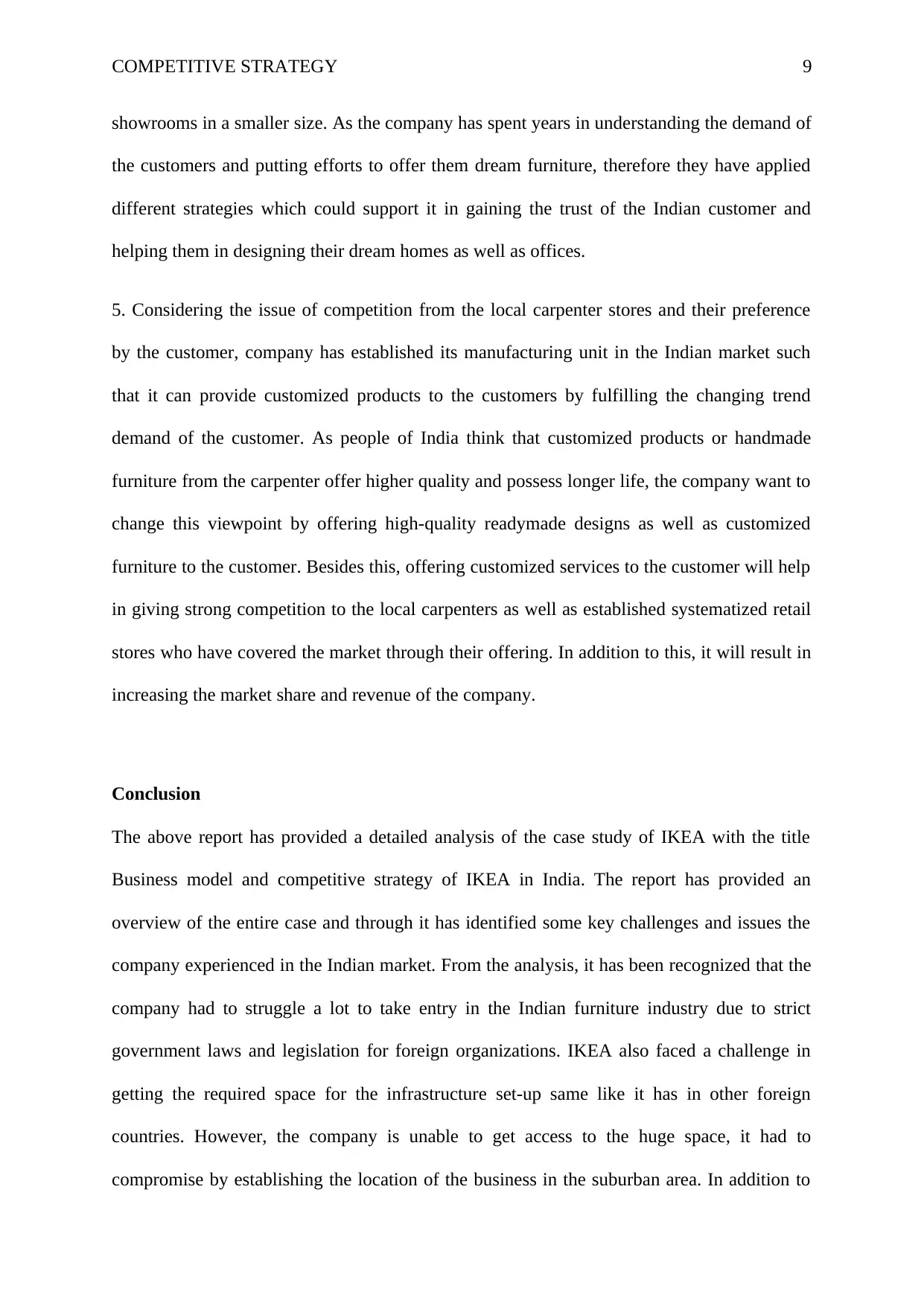
COMPETITIVE STRATEGY 9
showrooms in a smaller size. As the company has spent years in understanding the demand of
the customers and putting efforts to offer them dream furniture, therefore they have applied
different strategies which could support it in gaining the trust of the Indian customer and
helping them in designing their dream homes as well as offices.
5. Considering the issue of competition from the local carpenter stores and their preference
by the customer, company has established its manufacturing unit in the Indian market such
that it can provide customized products to the customers by fulfilling the changing trend
demand of the customer. As people of India think that customized products or handmade
furniture from the carpenter offer higher quality and possess longer life, the company want to
change this viewpoint by offering high-quality readymade designs as well as customized
furniture to the customer. Besides this, offering customized services to the customer will help
in giving strong competition to the local carpenters as well as established systematized retail
stores who have covered the market through their offering. In addition to this, it will result in
increasing the market share and revenue of the company.
Conclusion
The above report has provided a detailed analysis of the case study of IKEA with the title
Business model and competitive strategy of IKEA in India. The report has provided an
overview of the entire case and through it has identified some key challenges and issues the
company experienced in the Indian market. From the analysis, it has been recognized that the
company had to struggle a lot to take entry in the Indian furniture industry due to strict
government laws and legislation for foreign organizations. IKEA also faced a challenge in
getting the required space for the infrastructure set-up same like it has in other foreign
countries. However, the company is unable to get access to the huge space, it had to
compromise by establishing the location of the business in the suburban area. In addition to
showrooms in a smaller size. As the company has spent years in understanding the demand of
the customers and putting efforts to offer them dream furniture, therefore they have applied
different strategies which could support it in gaining the trust of the Indian customer and
helping them in designing their dream homes as well as offices.
5. Considering the issue of competition from the local carpenter stores and their preference
by the customer, company has established its manufacturing unit in the Indian market such
that it can provide customized products to the customers by fulfilling the changing trend
demand of the customer. As people of India think that customized products or handmade
furniture from the carpenter offer higher quality and possess longer life, the company want to
change this viewpoint by offering high-quality readymade designs as well as customized
furniture to the customer. Besides this, offering customized services to the customer will help
in giving strong competition to the local carpenters as well as established systematized retail
stores who have covered the market through their offering. In addition to this, it will result in
increasing the market share and revenue of the company.
Conclusion
The above report has provided a detailed analysis of the case study of IKEA with the title
Business model and competitive strategy of IKEA in India. The report has provided an
overview of the entire case and through it has identified some key challenges and issues the
company experienced in the Indian market. From the analysis, it has been recognized that the
company had to struggle a lot to take entry in the Indian furniture industry due to strict
government laws and legislation for foreign organizations. IKEA also faced a challenge in
getting the required space for the infrastructure set-up same like it has in other foreign
countries. However, the company is unable to get access to the huge space, it had to
compromise by establishing the location of the business in the suburban area. In addition to
Paraphrase This Document
Need a fresh take? Get an instant paraphrase of this document with our AI Paraphraser
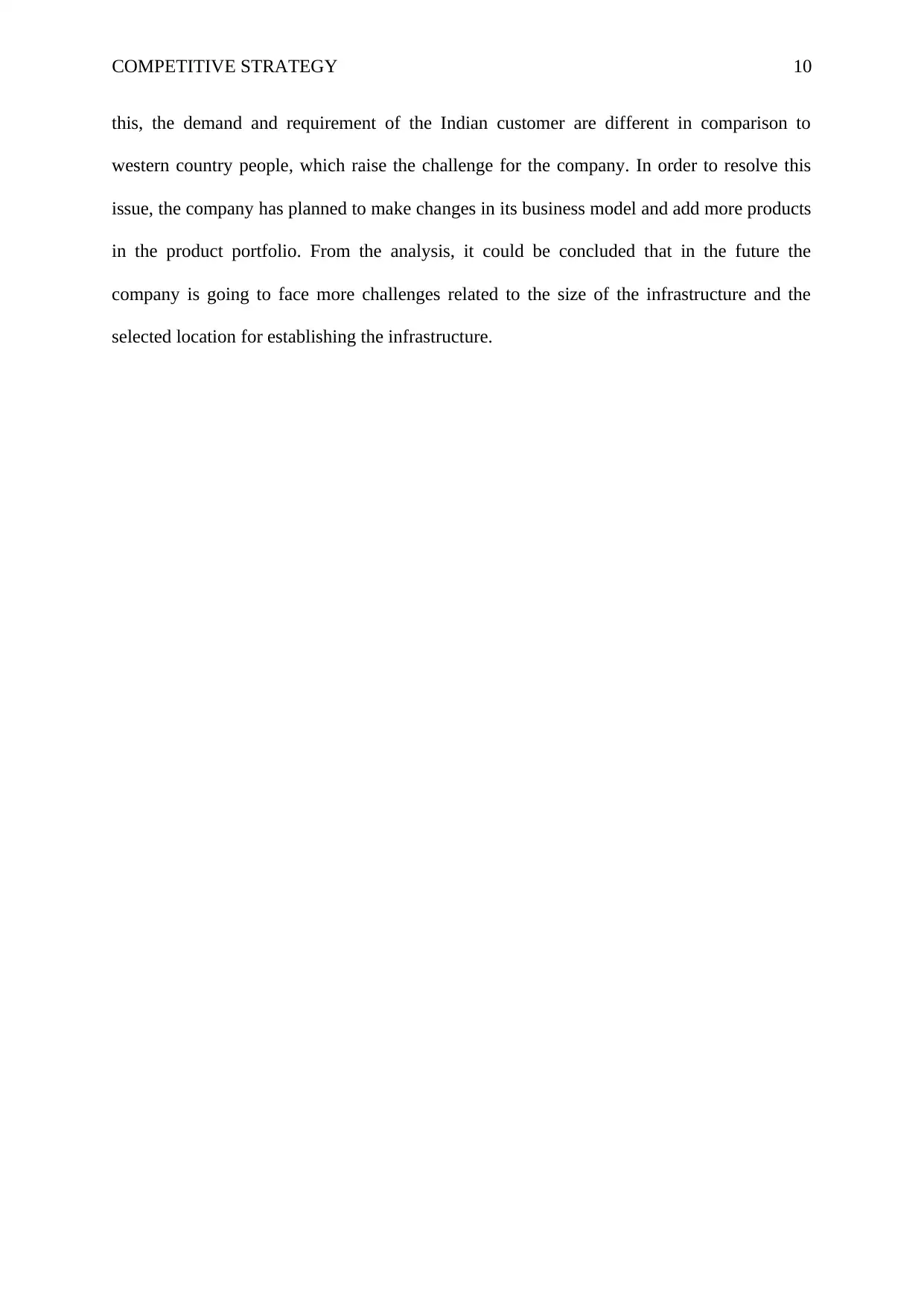
COMPETITIVE STRATEGY 10
this, the demand and requirement of the Indian customer are different in comparison to
western country people, which raise the challenge for the company. In order to resolve this
issue, the company has planned to make changes in its business model and add more products
in the product portfolio. From the analysis, it could be concluded that in the future the
company is going to face more challenges related to the size of the infrastructure and the
selected location for establishing the infrastructure.
this, the demand and requirement of the Indian customer are different in comparison to
western country people, which raise the challenge for the company. In order to resolve this
issue, the company has planned to make changes in its business model and add more products
in the product portfolio. From the analysis, it could be concluded that in the future the
company is going to face more challenges related to the size of the infrastructure and the
selected location for establishing the infrastructure.
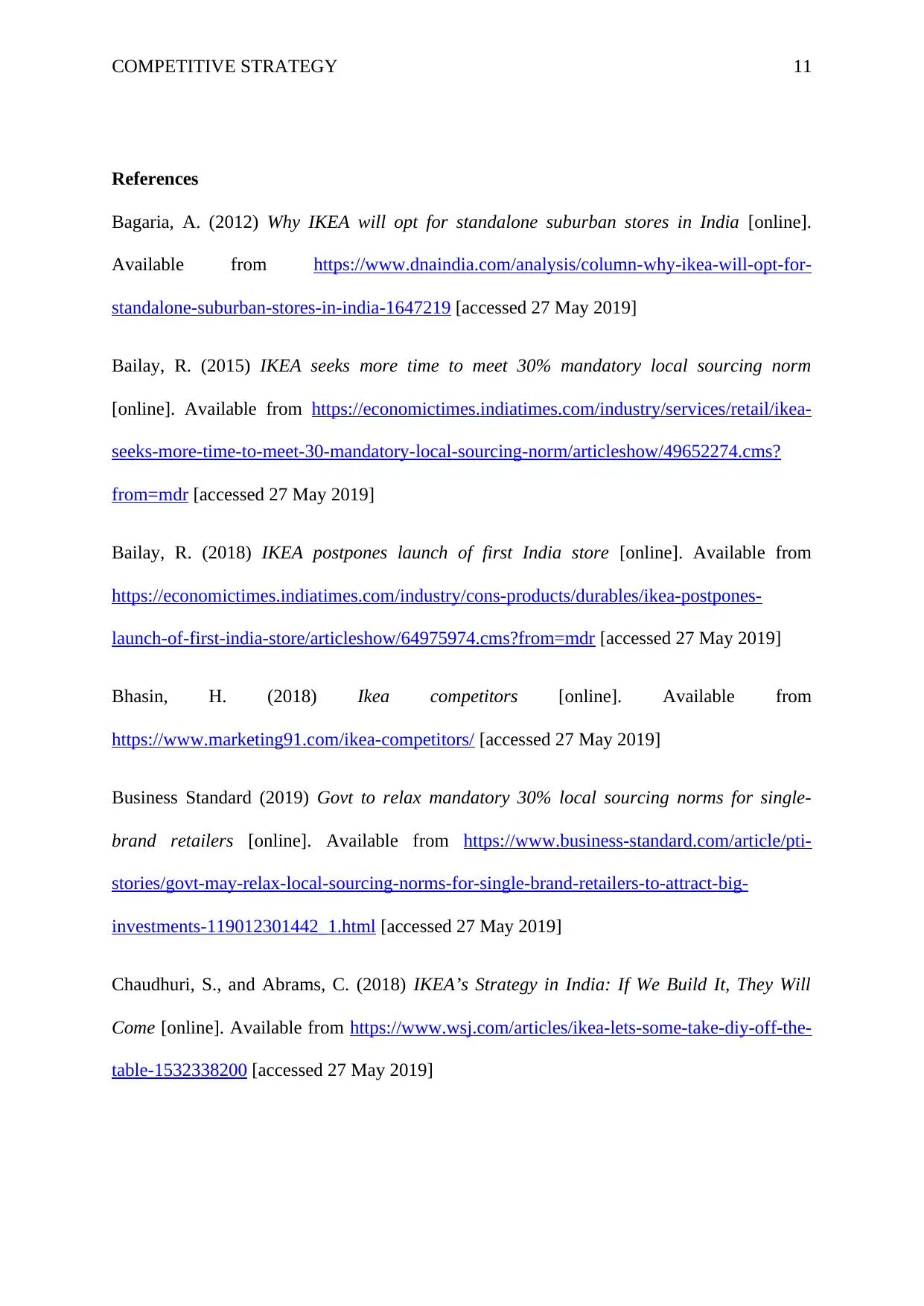
COMPETITIVE STRATEGY 11
References
Bagaria, A. (2012) Why IKEA will opt for standalone suburban stores in India [online].
Available from https://www.dnaindia.com/analysis/column-why-ikea-will-opt-for-
standalone-suburban-stores-in-india-1647219 [accessed 27 May 2019]
Bailay, R. (2015) IKEA seeks more time to meet 30% mandatory local sourcing norm
[online]. Available from https://economictimes.indiatimes.com/industry/services/retail/ikea-
seeks-more-time-to-meet-30-mandatory-local-sourcing-norm/articleshow/49652274.cms?
from=mdr [accessed 27 May 2019]
Bailay, R. (2018) IKEA postpones launch of first India store [online]. Available from
https://economictimes.indiatimes.com/industry/cons-products/durables/ikea-postpones-
launch-of-first-india-store/articleshow/64975974.cms?from=mdr [accessed 27 May 2019]
Bhasin, H. (2018) Ikea competitors [online]. Available from
https://www.marketing91.com/ikea-competitors/ [accessed 27 May 2019]
Business Standard (2019) Govt to relax mandatory 30% local sourcing norms for single-
brand retailers [online]. Available from https://www.business-standard.com/article/pti-
stories/govt-may-relax-local-sourcing-norms-for-single-brand-retailers-to-attract-big-
investments-119012301442_1.html [accessed 27 May 2019]
Chaudhuri, S., and Abrams, C. (2018) IKEA’s Strategy in India: If We Build It, They Will
Come [online]. Available from https://www.wsj.com/articles/ikea-lets-some-take-diy-off-the-
table-1532338200 [accessed 27 May 2019]
References
Bagaria, A. (2012) Why IKEA will opt for standalone suburban stores in India [online].
Available from https://www.dnaindia.com/analysis/column-why-ikea-will-opt-for-
standalone-suburban-stores-in-india-1647219 [accessed 27 May 2019]
Bailay, R. (2015) IKEA seeks more time to meet 30% mandatory local sourcing norm
[online]. Available from https://economictimes.indiatimes.com/industry/services/retail/ikea-
seeks-more-time-to-meet-30-mandatory-local-sourcing-norm/articleshow/49652274.cms?
from=mdr [accessed 27 May 2019]
Bailay, R. (2018) IKEA postpones launch of first India store [online]. Available from
https://economictimes.indiatimes.com/industry/cons-products/durables/ikea-postpones-
launch-of-first-india-store/articleshow/64975974.cms?from=mdr [accessed 27 May 2019]
Bhasin, H. (2018) Ikea competitors [online]. Available from
https://www.marketing91.com/ikea-competitors/ [accessed 27 May 2019]
Business Standard (2019) Govt to relax mandatory 30% local sourcing norms for single-
brand retailers [online]. Available from https://www.business-standard.com/article/pti-
stories/govt-may-relax-local-sourcing-norms-for-single-brand-retailers-to-attract-big-
investments-119012301442_1.html [accessed 27 May 2019]
Chaudhuri, S., and Abrams, C. (2018) IKEA’s Strategy in India: If We Build It, They Will
Come [online]. Available from https://www.wsj.com/articles/ikea-lets-some-take-diy-off-the-
table-1532338200 [accessed 27 May 2019]
⊘ This is a preview!⊘
Do you want full access?
Subscribe today to unlock all pages.

Trusted by 1+ million students worldwide
1 out of 13
Related Documents
Your All-in-One AI-Powered Toolkit for Academic Success.
+13062052269
info@desklib.com
Available 24*7 on WhatsApp / Email
![[object Object]](/_next/static/media/star-bottom.7253800d.svg)
Unlock your academic potential
Copyright © 2020–2025 A2Z Services. All Rights Reserved. Developed and managed by ZUCOL.




